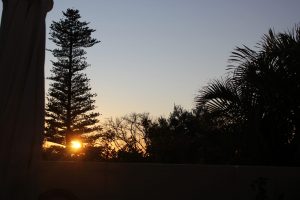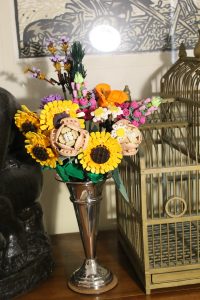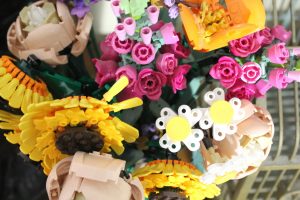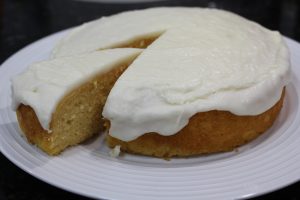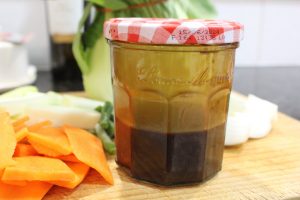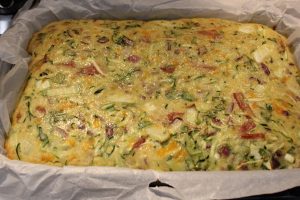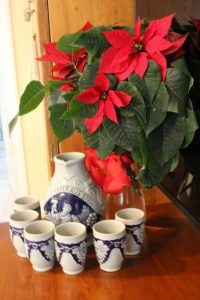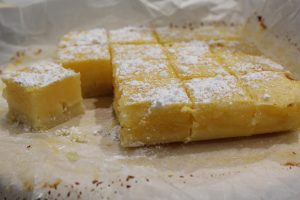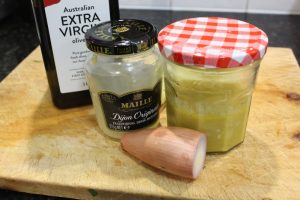We have a large shopping centre nearby. It has two supermarkets, one where we get some fruit and vegetables, plus sheep’s yoghurt and goat’s cheese, eggs, fish and often meat and always chicken. The other supermarket is where we buy pasta, frozen vegetables, crackers and biscuits and a few other things. I only prepare meals for two of us most of the time, so our shopping trolley isn’t very full. Most of our fresh fruit and vegetables come from a green grocer.


There is a whole array of other shops at the local shopping centre. There’s a David Jones, a department store, lots of clothing stores including R.M.Williams, Country Road and Camilla and Marc, cafes, a lovely gift shop and a Chanel shop. Plus lots of other shops like hairdressers, bedding supplies, a bank inside and two others nearby, also Mecca, which claims to be Australia’s biggest beauty retailer. I hope the gangs of very young girls I see in there buying skin care products are also buying sunscreen. Good places to eat close by, including a hotel and other cafes.


Image Pixabay
Australia is experiencing high inflation and a cost of living crisis. This became really clear to me last week when I walked through the shopping centre. This once vibrant and busy shopping centre with good parking and everything from cut flowers to a new dinner set or a hair cut was strangely quiet. It was easy to get around. No long waits at the checkout. Also, not many sales assistants, although I was lucky to snag one who was very helpful. Customers in the coffee shops, but none were crowded. Sales advertised in most display windows.
In August, Channel 9 (here) claimed about 4 million Australians were struggling to buy food. Inflation is blamed on pressures due to high energy costs and labour shortages. Producers complain that they are being paid less and less by the buyers from the big supermarket chains. Primary producers are paying more for fuel, fertilizer, labour and transport. Politicians are threatening an inquiry into price gouging by the supermarkets. This problem apparently exists in Britain and the USA where similar inquiries are threatened. Inflation is a universal problem caused by quantitative easing and all the money spent by governments during the Covid epidemic.
Read in the Sunday paper that Woolworths, one of our two big supermarket chains, announced a net profit of $1.7 billion. This was later reduced to $108 million because of an ‘impairment’ to its New Zealand business. Coles, the other big supermarket chain, posted an annual $1.1 billion profit this week, a 10% increase. This duopoly controls 65% of Australia’s grocery market. (Source The Sunday Times, Sunday 1st September 2024)
roast lamb’


Sunday, 1st September was Father’s Day in Australia. Our son flew in from Singapore, en route from Taipei to Kalgoorlie, so we had a lovely weekend. I asked my husband what he’d like for Father’s Day lunch and he said Roast Lamb. I grew up on a farm and I think it was easy for my Father to butcher a lamb by himself, whereas he needed help for a bigger beast, so we ate a lot of lamb! I think we ate bacon for breakfast (we had a piggery, too) then beef or lamb for lunch and dinner. I don’t remember eating a lot of chicken but we ate a lot of duck in season. A friend of my Grandfather was a keen fisherman and I remember him exchanging fish for meat.
So for years I haven’t eaten pork, except ham and bacon in moderation and I haven’t eaten lamb. I wasn’t confident about cooking the leg of lamb I bought and as usual, sought Nagi’s recipetineats.com method and followed it exactly. Picked lots of rosemary and some mint for the peas and did as directed. The lamb turned out pink and beautifully cooked. The rest of the family were very pleased with it too. Made the gravy following the recipe and even sieved it, as instructed in the recipe, to remove the garlic skins, rosemary twigs and big bits of roasted onion. This was the best gravy, silky and rich but not overpowering. I also used her recipe for Crunchy Roast Potatoes, which were just fabulous.


Nagi suggested pushing the gravy through a sieve. Did as instructed, great gravy.


I’d made the pudding beforehand. We had a lot of red apples in the fruit bowl and I felt they needed using up. Generally Apple Crumble is made from green apples such as Granny Smith’s. Again, straight to Nagi’s Apple Crumble recipe. The scent of cooking apples and cinnamon was lovely. So was the Apple Crumble, served with vanilla icecream.


We had a lovely day with great food and the best part…lots of leftovers for dinner that night!

